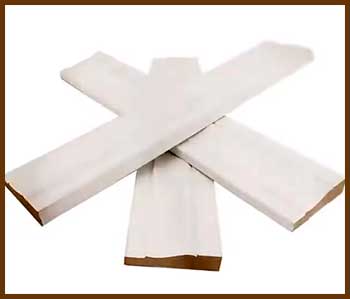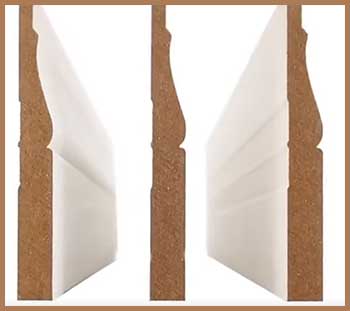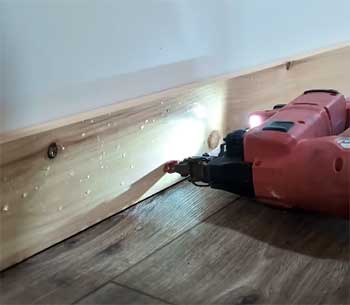I’ve spent years renovating homes, and one question keeps popping up: MDF or wood baseboards? Choosing the right material can transform a room’s look and durability while keeping your budget in check.
In this article, I’ll walk you through the ins and outs of MDF (medium-density fiberboard) and wood baseboards, comparing their strengths and weaknesses. My goal is to help you make an informed decision for your home, whether you’re a DIY enthusiast or hiring a pro.
Let’s get started with a side-by-side comparison to set the stage.
A Brief Comparison Table
| Feature | MDF Baseboards | Wood Baseboards |
| Material | Engineered wood fiber composite | Solid natural wood (pine, oak, etc.) |
| Cost | Budget-friendly ($0.50–$1.50/ft) | More expensive ($1–$5/ft) |
| Durability | Prone to moisture damage | Durable, resists moisture better |
| Appearance | Smooth, uniform, pre-primed | Natural grain, customizable stain |
| Installation | Easy to cut, lightweight | Heavier, may require more skill |
| Maintenance | Low, but less forgiving to damage | Moderate, can be sanded/refinished |
| Environmental Impact | Recycled content, less sustainable | Sustainable if sourced responsibly |
| Customization | Limited to paint | Paint or stain options |
Understanding MDF Baseboards

When I first tackled a home renovation, MDF baseboards caught my attention for their affordability.
MDF, or medium-density fiberboard, is made by compressing wood fibers with resin under high pressure.
The result?
A smooth, consistent material that’s a favorite for budget-conscious projects.
I’ve installed MDF in several rooms, and its pre-primed surface makes painting a breeze—no sanding or priming needed. It’s like a blank canvas, ready for any color you choose.
But MDF isn’t perfect. Its biggest drawback is moisture sensitivity. I learned this the hard way when a small bathroom leak caused an MDF baseboard to swell and warp. It’s not ideal for humid areas like bathrooms or basements unless properly sealed.
On the flip side, MDF’s uniformity means no knots or imperfections, giving you a sleek, modern look. It’s also lightweight, making it easy to handle during installation, especially for long runs along a wall.
Another perk is MDF’s eco-friendly angle. Many manufacturers use recycled wood fibers, which feels like a small win for the environment. However, the resin in MDF can off-gas formaldehyde, so I always check for low-VOC or formaldehyde-free options.
Cost-wise, MDF is a steal—often half the price of wood. For a recent project, I paid about $0.75 per foot for MDF baseboards, compared to $2.50 for pine. That’s a significant saving for large spaces.
Pros And Cons of MDF Baseboards
Let’s break down the advantages and drawbacks of MDF baseboards. I’ve used them in multiple projects, so I can share what stands out.
Pros
- Affordability: MDF is a budget-saver. I’ve completed entire rooms for under $100 in materials, which is tough to beat.
- Smooth Finish: The lack of grain or knots means you get a flawless surface right out of the box. I love how paint glides on without extra prep.
- Lightweight: MDF is easy to carry and cut. I’ve hauled 12-foot lengths up stairs without breaking a sweat.
- Eco-Friendly Options: Many MDF products use recycled materials, which aligns with my goal to reduce waste.
- Consistency: Every piece looks identical, making it ideal for modern, minimalist designs.
Cons
- Moisture Sensitivity: As I mentioned, MDF doesn’t handle water well. A single spill can ruin it if not addressed quickly.
- Brittleness: MDF can chip or crack under impact. I once dented a piece while moving furniture, and it wasn’t fixable.
- Limited Customization: You’re stuck with painting MDF. Staining isn’t an option, which limits design flexibility.
- Environmental Concerns: Some MDF contains formaldehyde, which can affect indoor air quality. I always look for low-VOC certifications.
- Non-Repairable: Unlike wood, you can’t sand or refinish MDF. Damage often means replacement.
Exploring Wood Baseboards

Wood baseboards, on the other hand, bring a timeless charm to any room.
I’ve worked with pine, oak, and poplar, and each has its own personality.
Pine is soft and affordable, oak is sturdy with beautiful grain, and poplar strikes a balance between cost and durability.
When I installed oak baseboards in my living room, the natural wood grain added warmth that MDF couldn’t match. You can stain wood to highlight its texture or paint it for a clean look.
Durability is wood’s strong suit. Unlike MDF, solid wood holds up better against moisture and physical damage. I’ve seen wood baseboards in older homes last decades with minimal wear, especially when properly maintained.
You can sand and refinish wood if it gets scratched or scuffed, which I’ve done to revive baseboards in a fixer-upper. MDF, once damaged, is harder to repair.
However, wood comes with challenges. It’s pricier, and costs vary by species—oak or walnut can set you back $3–$5 per foot. Natural wood also has imperfections like knots or grain variations, which can be a pro or con depending on your aesthetic.
I once spent hours sanding knots on pine baseboards to get a smooth finish for painting. Installation can also be trickier, as wood is heavier and may require more precise cuts to account for natural warping.
Pros And Cons of Wood Baseboards
Wood baseboards have their own set of strengths and weaknesses, based on my experience installing them in various homes.
Pros
- Durability: Wood can take a beating. I’ve seen oak baseboards withstand years of kids and pets with only minor scuffs.
- Aesthetic Versatility: You can paint or stain wood to match any style. I stained poplar baseboards for a rustic vibe in a cabin project.
- Repairability: Scratches or dents? Sand and refinish. I’ve restored worn wood baseboards to look brand new.
- Longevity: Properly maintained, wood baseboards can last a lifetime. I’ve worked on century-old homes with original wood trim still intact.
- Natural Beauty: The grain and texture of wood add character that MDF can’t replicate.
Cons
- Higher Cost: Wood is a bigger investment. I budgeted $300 for wood baseboards in a small room, compared to $100 for MDF.
- Maintenance: Wood needs periodic care, like sealing or refinishing, especially in high-traffic areas.
- Inconsistencies: Knots, grain variations, or warping can complicate installation. I’ve had to reject warped boards at the store.
- Weight: Wood is heavier, making it harder to maneuver for long pieces or solo installations.
- Sustainability Concerns: Not all wood is responsibly sourced. I always check for FSC-certified options to ensure eco-friendliness.
Key Features of MDF And Wood Baseboard To Consider
When choosing between MDF and wood, I focus on a few critical factors: cost, durability, aesthetics, installation, and environmental impact. Let’s explore each to help you decide.
- Cost

For me, budget often dictates the choice.
MDF is consistently cheaper, making it ideal for large projects or rentals where cost trumps longevity.
I’ve used MDF in apartments where I wanted a polished look without breaking the bank.
Wood, while pricier, feels like an investment in high-value spaces like living rooms or historic homes.
If you’re on a tight budget, MDF is your friend; if you can splurge, wood’s worth it.
- Durability
Durability is where wood shines. I’ve seen wood baseboards survive heavy furniture bumps and still look great after a quick refinish. MDF, however, struggles in high-traffic or humid areas.
If you’re installing baseboards in a bathroom or laundry room, I’d lean toward wood or at least seal MDF meticulously. For dry, low-traffic spaces like bedrooms, MDF holds up fine.
- Aesthetics
Your style matters. MDF’s smooth surface screams modern simplicity, which I love for contemporary homes. Wood, with its grain and texture, suits traditional or rustic vibes.
I once paired stained oak baseboards with hardwood floors for a cohesive, warm look. If you want flexibility to stain or paint, wood’s the way to go. For a clean, painted finish, MDF gets the job done.
- Installation
As a DIYer, I appreciate MDF’s ease of use. It cuts like butter with a basic saw, and its light weight makes handling a breeze. Wood requires more skill, especially with harder species like oak, which can splinter if not cut properly.
I’ve spent extra time aligning wood baseboards to account for natural warping, something MDF rarely demands.
- Environmental Impact
Sustainability is a growing concern for me. MDF often uses recycled fibers, but the resins can raise environmental red flags. Wood, when sourced responsibly (look for FSC certification), feels like a greener choice.
I’ve started prioritizing sustainable wood for clients who value eco-conscious builds, though MDF’s recycled content is a decent alternative for budget projects.
Practical Applications And Real-Life Scenarios

Let’s talk real-world use.
In my last rental property flip, I used MDF baseboards in bedrooms and living areas to keep costs low.
The smooth, painted finish looked sharp and appealed to tenants.
But in the bathroom, I opted for pine baseboards with a waterproof sealant to handle humidity.
The result?
A cohesive look with practical material choices.
For a high-end home renovation, I went all-in on oak baseboards. The client wanted a classic look, and staining the oak to match the hardwood floors elevated the space. The upfront cost was higher, but the durability and aesthetic payoff were worth it.
If you’re renovating for resale, MDF can boost appeal on a budget. For a forever home, wood’s longevity makes it a smarter pick.
Maintenance And Long-Term Care
Maintaining baseboards is often overlooked, but it’s crucial. MDF is low-maintenance for painting—just a quick wipe-down and occasional touch-up.
But if it gets damaged, you’re often stuck replacing it. I’ve had to swap out MDF sections after minor water exposure, which was frustrating.
Wood requires more upkeep but offers flexibility. I’ve sanded and restained wood baseboards to refresh a room without replacing anything.
Regular dusting and occasional sealing keep wood looking great. In high-traffic areas like hallways, I check wood baseboards yearly for scuffs and touch them up as needed.
Making The Right Choice For Your Home
So, how do you choose? I ask myself these questions: What’s my budget? Where are the baseboards going? What’s the room’s style?
For a quick, affordable update in a dry space, MDF is hard to beat. Its smooth finish and low cost make it a go-to for rentals or starter homes. If I’m aiming for durability and a custom look, wood wins—especially in high-value or humid areas.
Consider your lifestyle, too. If you have kids or pets, wood’s repairability is a lifesaver. For a sleek, modern aesthetic on a budget, MDF delivers.
I’ve mixed both in projects—wood in main living areas, MDF in secondary spaces—to balance cost and quality.
Frequently Asked Questions (FAQ)
It depends on your needs. MDF is cheaper and easier to install, ideal for budget projects or dry areas. Wood is more durable and versatile, perfect for high-traffic or humid spaces.
MDF is prone to moisture damage, brittle under impact, and can’t be stained or easily repaired. Some types may also release formaldehyde, affecting air quality.
Neither is universally better. MDF suits tight budgets and modern aesthetics; wood excels in durability and customization. Choose based on your space and priorities.
There’s no one-size-fits-all. Wood is best for longevity and style flexibility, especially in humid or high-traffic areas. MDF works for cost-effective, painted finishes in dry spaces.
Wrapping Up
Choosing between MDF and wood baseboards comes down to your priorities—budget, durability, or style. I’ve shared my experiences to help you weigh the pros and cons, from MDF’s affordability to wood’s timeless appeal.
Whether you’re sprucing up a rental or building your dream home, I hope this guide empowers you to pick the right material. Think about your space, your budget, and the look you’re after, and you’ll find the perfect fit.
Happy renovating!
